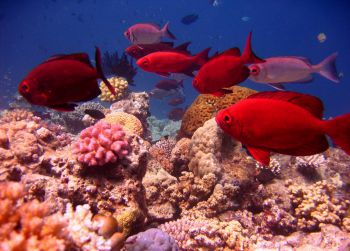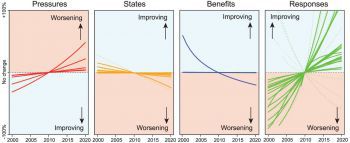More investment needed to reach international biodiversity targets by 2020
More needs to be done to reach an internationally agreed set of biodiversity goals by 2020, according to a study co-authored by a Sussex academic.
Dr Jörn Scharlemann, Reader in Ecology and Conservation, is among a team of experts who have produced a paper published in Science this month assessing the current progress towards a set of 20 ‘Aichi Biodiversity Targets’, as agreed in 2010 by 193 nations.
The experts, from more than 30 institutions, have revealed that despite increasing management efforts and financial investment in biodiversity conservation, and expansion of protected areas on land and at sea, accumulated and increasing pressures on the natural world mean it is unlikely that most of the targets will be met by 2020 on the current trajectory.
 Priacanthus hamrur in the Great Barrier Reef
Priacanthus hamrur in the Great Barrier Reef
 Aggregated trends across all biodiversity indicators, showing that the pressures on biodiversity continue to increase, resulting in a decline in the state of biodiversity despite increasing biodiversity conservation efforts (responses).
Aggregated trends across all biodiversity indicators, showing that the pressures on biodiversity continue to increase, resulting in a decline in the state of biodiversity despite increasing biodiversity conservation efforts (responses).
To assess progress, the experts used a broad range of indicators on biodiversity and human interactions with biodiversity such as global bottom-trawl fishing pressure, efforts to manage invasive species, financial investment, and public understanding of biodiversity.
Dr Scharlemann, who is also a senior fellow at the United Nations Environment Programme World Conservation Monitoring Centre, says: “Our analysis has shown that we are making some progress but currently are not on track to meet the internationally-agreed Aichi Biodiversity Targets; biodiversity continues to decline despite increasing conservation efforts and policies.
“Numerous policies and conservation actions are successful at halting or slowing biodiversity loss, such as effectively managed protected areas. Hopefully our findings will act as a wake-up call to step up conservation resources to meet the targets by 2020.”
As shown in the Science paper, increased pressures on biodiversity suggest that the situation is worsening. Decreasing wetland extent and declining coral cover reflect large-scale habitat loss. At current rates, the Aichi Biodiversity Targets to halve the rate of natural habitat loss and sustainably harvest all fish stocks will not be achieved - but there remains sufficient time to change this outcome.
Substantial progress is being made on some individual targets,say the authors. Certification schemes for forests and fisheries are becoming more widespread. Policy interventions have resulted in reduced deforestation and led to better managed fisheries stocks in some regions. There is also growing public awareness of biodiversity. Financial resources are being made available to address the biodiversity crisis, but more investment is needed to fulfil all targets.
